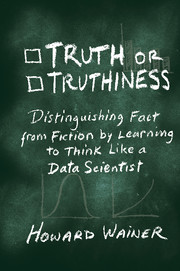Book contents
- Frontmatter
- Dedication
- Contents
- Preface and Acknowledgments
- Introduction
- Section I Thinking Like a Data Scientist
- 1 How the Rule of 72 Can Provide Guidance to Advance Your Wealth, Your Career, and Your Gas Mileage
- 2 Piano Virtuosos and the Four-Minute Mile
- 3 Happiness and Causal Inference
- 4 Causal Inference and Death
- 5 Using Experiments to Answer Four Vexing Questions
- 6 Causal Inferences from Observational Studies: Fracking, Injection Wells, Earthquakes, and Oklahoma
- 7 Life Follows Art: Gaming the Missing Data Algorithm
- Section II Communicating Like a Data Scientist
- Section III Applying the Tools of Data Science to Education
- Section IV Conclusion: Don't Try Th is at Home
- Bibliography
- Sources
- Index
2 - Piano Virtuosos and the Four-Minute Mile
from Section I - Thinking Like a Data Scientist
Published online by Cambridge University Press: 05 December 2015
- Frontmatter
- Dedication
- Contents
- Preface and Acknowledgments
- Introduction
- Section I Thinking Like a Data Scientist
- 1 How the Rule of 72 Can Provide Guidance to Advance Your Wealth, Your Career, and Your Gas Mileage
- 2 Piano Virtuosos and the Four-Minute Mile
- 3 Happiness and Causal Inference
- 4 Causal Inference and Death
- 5 Using Experiments to Answer Four Vexing Questions
- 6 Causal Inferences from Observational Studies: Fracking, Injection Wells, Earthquakes, and Oklahoma
- 7 Life Follows Art: Gaming the Missing Data Algorithm
- Section II Communicating Like a Data Scientist
- Section III Applying the Tools of Data Science to Education
- Section IV Conclusion: Don't Try Th is at Home
- Bibliography
- Sources
- Index
Summary
“Virtuosos becoming a dime a dozen,” exclaimed Anthony Tommasini, chief music critic of the New York Times in his column in the arts section of that newspaper on Sunday, August 14, 2011. Tommasini described, with some awe, the remarkable increase in the number of young musicians whose technical proficiency on the piano allows them to play anything. He contrasts this with some virtuosos of the past – he singles out Rudolf Serkin as an example – who had only the technique they needed to play the music that was meaningful to them. Serkin did not perform pieces like “Prokofiev's finger twisting Third Piano Concerto or the mighty Liszt Sonata,” although such pieces are well within the capacity of most modern virtuosos.
But why? Why have so many young pianists set “a new level of conquering the piano”? Tommasini doesn't attempt to answer this question (although he does mention Roger Bannister in passing), so let me try.
We see an apparently unending upward spiral in remarkable levels of athletic achievement that provides a context to consider Tommasini's implicit riddle. I don't mean to imply that this increase in musical virtuosity is due to improved diet and exercise, or even to better coaching; although I would be the last to gainsay their possible contribution. I think a major contributor to this remarkable increase in proficiency is population size. I'll elaborate.
The world record for running the mile has steadily improved by almost four-tenths of a second a year for the past century. When the twentieth century began the record was 4:13. It took almost fifty years until Roger Bannister collapsed in exhaustion after completing a mile in just less than four minutes. In a little more than a decade his record was being surpassed by high school runners. And, by the end of the twentieth century, Hicham El Guerrouj broke the tape at 3:43. What happened? How could the capacity of humans to run improve so drastically in such a relatively short time? Humans have been running for a very long time, and in the more distant past, the ability to run quickly was far more important for survival than it is today.
- Type
- Chapter
- Information
- Truth or TruthinessDistinguishing Fact from Fiction by Learning to Think Like a Data Scientist, pp. 19 - 21Publisher: Cambridge University PressPrint publication year: 2015



